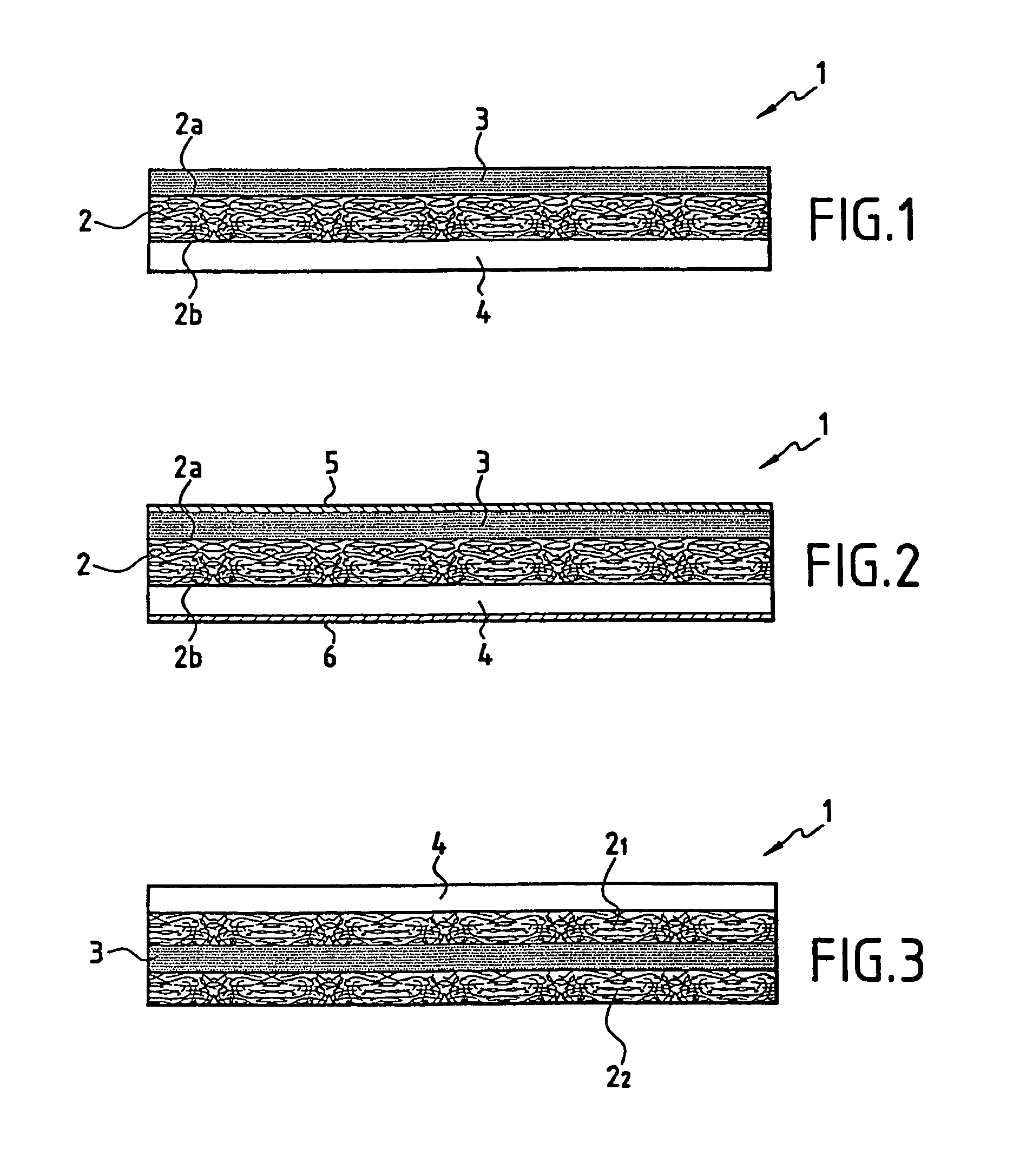Composite products and molded articles obtained from said products
a technology of composite products and molded articles, applied in the field of composite products, can solve the problems of cross-linking reaction, slow, to be sure, thermosetting resin, and difficult storage of pre-pregs at room temperature, and achieve the effects of convenient handling, optimized performance of the obtained articles, and easy implementation
- Summary
- Abstract
- Description
- Claims
- Application Information
AI Technical Summary
Benefits of technology
Problems solved by technology
Method used
Image
Examples
example 1
[0047]A composite product 1 according to FIG. 3 is produced with the following multilayer structure: layer 22 of an 8-harness satin weave glass fabric marketed under style 7781 by Hexcel Fabrics with a 303-g / m2 surface mass, covered with an LY 1556 thermosetting-resin based layer 3, covered with a second fibrous reinforcement 21 identical to the first 22, covered itself with an HY 5052 hardening-agent based layer 4. The thermosetting resin content before polymerization is about 43% by weight. The formulation is LY 5052 (72.5%), HY 5052 (27.5%).
[0048]A laminated item is constructed by stacking five of the composite products according to Example 1. Vibrations are applied at room temperature. The polymerization reaction is conducted over 12 hours at 80° C. at low pressure. The laminated item obtained presents a satisfactory appearance, it is pale green in color and the components have been totally mixed.
example 2
[0049]A composite product 1 according to FIG. 5 is constructed with the following multilayer structure: layer 22 of glass fabric (Style 7781) with a 303-g / m2 surface weight, covered with a layer 4 of Curimid NB hardening agent incorporating a 20-g / m2 light glass cloth 7, covered with a second fibrous reinforcement 21, identical to the first 22, covered itself with a layer 31 of thermosetting resin based on LY 1556 and GT 6071. The formulation is LY 1556 (64.4%), GT 6071 (27.6%) and Curimid NB (8.0%). The thermosetting resin content before polymerization is about 44% by weight. The composite product 1 shown in FIG. 5 has high tack and high flow.
[0050]A laminated item is constructed by stacking four composite products according to Example 2. Vibrations are applied at 50° C. The polymerization reaction is conducted over 4 hours at 80° C. under low pressure. The laminate obtained presents a satisfactory appearance; it is dark in color.
example 3
[0051]A composite product 1 according to FIG. 4 is constructed with the following multilayer structure: layer 32 of thermosetting resin based on LY 1556 and GT 6071, covered with a layer 22 of glass fabric (Style 7781) with a 303-g / m2 surface weight covered with a layer 4 of Curimid NB hardening agent incorporating a 20-g / m2 light glass fabric 7, covered with a second fibrous reinforcement 21, identical to the first 22, covered itself with a layer 31 of thermosetting resin based on LY 1556 and GT 6071. The formulation is LY 1556 (64.4%), GT 6071 (27.6%) and Curimid NB (8.0%).
[0052]The thermosetting resin content before polymerization is about 44% by weight. The composite product 1 shown in FIG. 4 presents high tack and high flow.
[0053]A laminated item is constructed by stacking four composite product 1 according to Example 3. Viibrations are applied to 50° C. The polymerization reaction is conducted over 2.5 hours at 80° C. under low pressure. The laminate obtained presents a satisf...
PUM
| Property | Measurement | Unit |
|---|---|---|
| temperatures | aaaaa | aaaaa |
| viscosity | aaaaa | aaaaa |
| viscosity | aaaaa | aaaaa |
Abstract
Description
Claims
Application Information
 Login to View More
Login to View More - R&D
- Intellectual Property
- Life Sciences
- Materials
- Tech Scout
- Unparalleled Data Quality
- Higher Quality Content
- 60% Fewer Hallucinations
Browse by: Latest US Patents, China's latest patents, Technical Efficacy Thesaurus, Application Domain, Technology Topic, Popular Technical Reports.
© 2025 PatSnap. All rights reserved.Legal|Privacy policy|Modern Slavery Act Transparency Statement|Sitemap|About US| Contact US: help@patsnap.com



